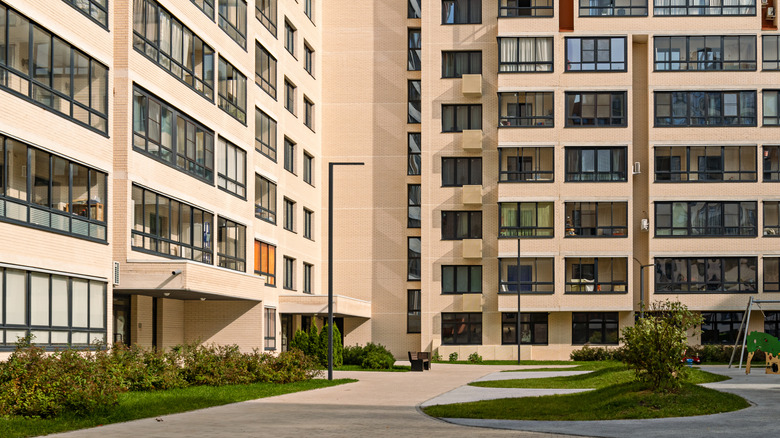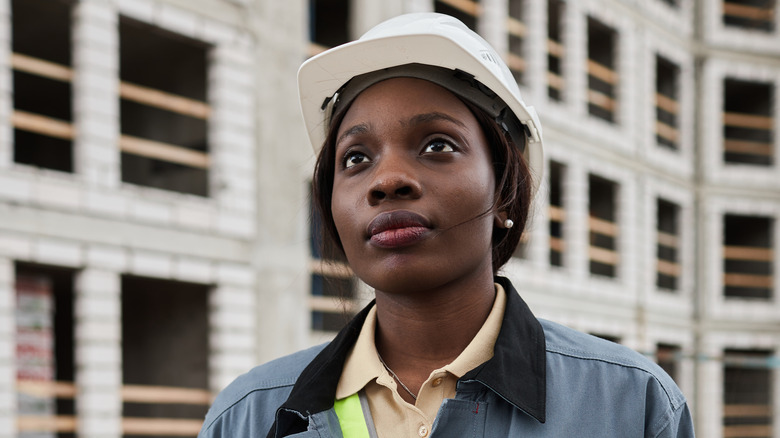Why Renovating A High Rise Can Be So Challenging And How To Do It
Renovating an apartment in a high rise building comes along with a unique set of challenges. Unlike a detached house, high rise homes are situated within a communal living space and this feature plays a large role in the planning and execution of any remodel. AMS Property Renovations note the potentially strict regulations imposed by governing bodies, while Candy's Dirt suggests that high rise renovations can actually be immensely rewarding if you take the time to visit open houses above and below your home.
Planning a renovation in the condensed space of an apartment requires a unique approach. In most buildings, stacked units (for instance numbers 123, 223, and 323) share a common layout and general floorplan. Visiting one of your neighbors to see the way they've used the space can help you come up with some great new ideas for your own remodel. With these factors in mind, planning and executing a renovation in your high rise building can be done with as little disruption and issue as possible.
Community guidelines can limit renovation scale
One of the first things that you'll need to consider when planning a renovation in a high rise are the community regulations, guidelines, and rules. Homeowner's associations play a somewhat muted role in typical suburban neighborhoods. Among these communities, guidelines are often built around curb appeal (maintaining the lawn, removing trash cans from the curb, keeping bulky vehicles off the roadways, etc.). This is not the case in apartment communities. Residential buildings share direct, common living spaces among their tenants, and so the regulations that guide how people in the building can and should behave are more stringent.
These regulations extend to home renovations and remodeling capabilities as well as general use of the premises, as noted by AMS Property Renovations. Regulations may stipulate when and how contractors and their teams can access the building, what kinds of permitting or permission is required to conduct the work, and perhaps even the types of additions that can be made to the property. For instance, your community may not allow the installation of gas stovetops.
Likewise, there are practical considerations to be taken onboard. Even if you are allowed the use of gas cooking equipment, if there isn't an existing hookup for the safe operation of this amenity, it's not feasible to install this feature. As well, it's typically not going to be practical to install a balcony in a high rise apartment setting.
Working hours may be limited by practicality and HOA rules
Community regulations often target working hours and the use of specialized tools, according to Marwood Construction. Demolition is often a crucial part in any home renovation project, but the deconstruction of a kitchen or bedroom comes along with a significant amount of noise, dust, and nuisance. Apartment building boards often regulate the hours within which a contracting team can work on your remodel in an effort to minimize the amount of irritation that your neighbors will have to endure. These are often common sense working hours that follow the same general timeline during which commuters are less likely to be at home, and therefore affected by the disturbance.
This can be a problem for homeowners looking to make renovations, but also having to spend their days in the office. Balancing these needs often requires the use of a general contractor who is competent and experienced as a project manager as well as in the role of remodeler. Additionally, the limited hours that many apartment owners face when working to make changes to their property can elongate the overall timeline of any renovation, making these considerations for balancing responsibilities an integral part of the project.
Significant planning must go into any changes
Making alterations to an apartment in a high rise building requires more comprehensive planning than a typical home remodel. A detached home is self-contained, with water and electrical circuits running in from the street. This gives homeowners the ability to temporarily turn off water and power connections to the entire worksite (from the street level). Renovating on a home is more straightforward and includes much fewer obstacles, as a result. Likewise, a renovation in your own home can be as in-depth and dramatic as you desire. Making substantial floorplan changes may not be the best idea, but virtually any change you can dream up is certainly possible in a living space and complete building structure that you own.
In an apartment, hookups and layout considerations aren't as flexible. You'll likely need to leave your kitchen and bathroom where they are, and working around live pipework may be unavoidable in certain areas of the home. Marwood Construction also notes that the spaces hidden behind your appliances and walls may play host to pipes and wiring that lead to other units, not just your own. This means that an added layer of planning and care must be present in any renovation that in a community living space.
Bringing materials into the worksite can be difficult
Homes that exist within the confines of a high rise building are also notoriously difficult to access when it comes to procuring and delivering materials. This is a topic of significant academic study all around the world, according to the Journal of Asian Architecture and Building Engineering. Plus, the problem of lifting essential equipment and materials persists across both the building and renovation spaces alike.
You might need many sheets of drywall or plywood to finish closing off a new room in your property, and depending on the amenities included in the building, these could be extremely difficult to bring onto the worksite. High rise buildings almost always have elevators built into their footprint, but if the box isn't very big and your building doesn't include a service elevator, it may be very difficult to facilitate the transfer of materials from the ground up to your home.
This is even more difficult for multi-story buildings that don't have elevators. In this case, contractors will have to haul materials up themselves or make use of crane additions to bring essential components up to the property. This doesn't even begin to consider heavy materials like granite countertops. Understanding that you may incur additional costs or have to work around these constraints altogether is crucial to successfully planning a renovation in apartment buildings.




